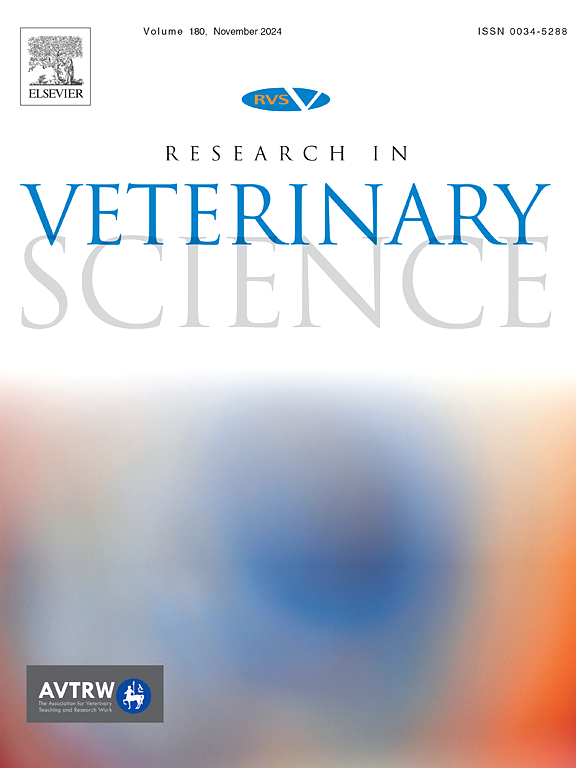Novel identification of telocytes in the skin of the desert tortoise (Testudo graeca): A correlative study using semithin section, transmission electron microscopy, and immunofluorescence
IF 2.2
3区 农林科学
Q1 VETERINARY SCIENCES
引用次数: 0
Abstract
This study comprehensively investigates the presence and characteristics of telocytes in the skin of desert tortoises, employing a multifaceted approach that includes light microscopy, transmission electron microscopy (TEM), and immunofluorescence analyses. A groundbreaking revelation is made as our study, for the first time, unveils the existence of telocytes in the skin of the Greek tortoise. The intricate architecture of the skin, comprising scales, a keratin layer, an epidermis, a dermis, and a hypodermis, is meticulously examined. The epidermis, marked by a stratified epithelium and a substantial keratin layer, features a corrugated basement membrane. Notably, the dermis is a significant site housing telocytes, identified by their distinctive rod-shaped morphology and extensive cytoplasmic processes, including a thick podom and a thin podomere containing nanovesicles. Extracellular nanovesicles play a crucial role in facilitating communication between telocytes and melanophores. Utilizing CD34, PDGFRα, and Vimentin markers, we observe the abundance and intensity of CD34, particularly in the central dermis, and the widespread presence of PDGFRα throughout the dermis. Although less abundant near the epidermis and hypodermis, Vimentin increases in the central dermis with reduced intensity compared to CD34 and PDGFRα. Co-expression analyses reveal robust associations between CD34 and PDGFRα, highlighting them as dominant markers in telocytes. This suggests their potential significance in supporting the tortoise's skin health and resilience in harsh desert conditions. The understanding of these molecular dynamics provides insights into the adaptive strategies employed by desert tortoises, emphasizing the therapeutic relevance of these markers in enhancing skin health in challenging environments.
沙漠陆龟(Testudo graeca)皮肤中远端细胞的新鉴定:半薄切片、透射电镜和免疫荧光的相关研究
本研究全面调查了沙漠龟皮肤中远端细胞的存在和特征,采用多方面的方法,包括光学显微镜、透射电子显微镜(TEM)和免疫荧光分析。我们的研究首次揭示了希腊龟皮肤中存在的远端细胞,这是一个开创性的发现。皮肤的复杂结构,包括鳞片、角蛋白层、表皮、真皮层和真皮,被仔细检查。表皮以层状上皮和大量角蛋白层为特征,基底膜呈波纹状。值得注意的是,真皮是居住远端细胞的重要部位,它们具有独特的杆状形态和广泛的细胞质突起,包括含有纳米囊泡的厚足丘和薄足丘。细胞外纳米囊泡在促进远端细胞和黑色素细胞之间的交流中起着至关重要的作用。利用CD34、PDGFRα和Vimentin标记,我们观察到CD34的丰度和强度,特别是在真皮中央,以及PDGFRα在真皮中的广泛存在。与CD34和PDGFRα相比,Vimentin虽然在表皮和真皮附近较少,但在真皮中央增加,但强度降低。共表达分析揭示了CD34和PDGFRα之间的强大关联,强调它们是远端细胞中的显性标记。这表明它们在支持龟在恶劣沙漠条件下的皮肤健康和恢复能力方面的潜在意义。对这些分子动力学的理解提供了对沙漠象龟采用的适应策略的见解,强调了这些标记在具有挑战性的环境中增强皮肤健康的治疗相关性。
本文章由计算机程序翻译,如有差异,请以英文原文为准。
求助全文
约1分钟内获得全文
求助全文
来源期刊

Research in veterinary science
农林科学-兽医学
CiteScore
4.40
自引率
4.20%
发文量
312
审稿时长
75 days
期刊介绍:
Research in Veterinary Science is an International multi-disciplinary journal publishing original articles, reviews and short communications of a high scientific and ethical standard in all aspects of veterinary and biomedical research.
The primary aim of the journal is to inform veterinary and biomedical scientists of significant advances in veterinary and related research through prompt publication and dissemination. Secondly, the journal aims to provide a general multi-disciplinary forum for discussion and debate of news and issues concerning veterinary science. Thirdly, to promote the dissemination of knowledge to a broader range of professions, globally.
High quality papers on all species of animals are considered, particularly those considered to be of high scientific importance and originality, and with interdisciplinary interest. The journal encourages papers providing results that have clear implications for understanding disease pathogenesis and for the development of control measures or treatments, as well as those dealing with a comparative biomedical approach, which represents a substantial improvement to animal and human health.
Studies without a robust scientific hypothesis or that are preliminary, or of weak originality, as well as negative results, are not appropriate for the journal. Furthermore, observational approaches, case studies or field reports lacking an advancement in general knowledge do not fall within the scope of the journal.
 求助内容:
求助内容: 应助结果提醒方式:
应助结果提醒方式:


